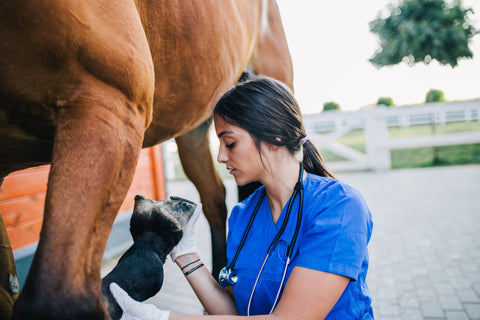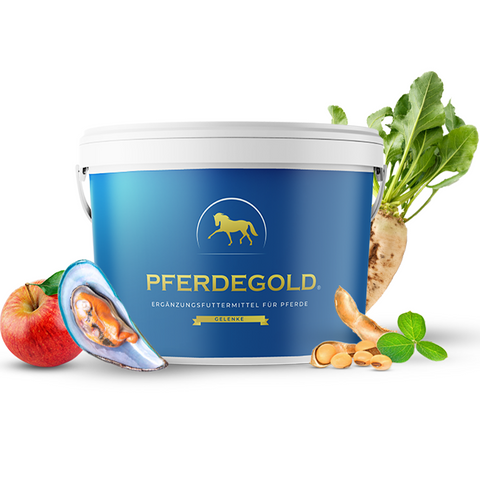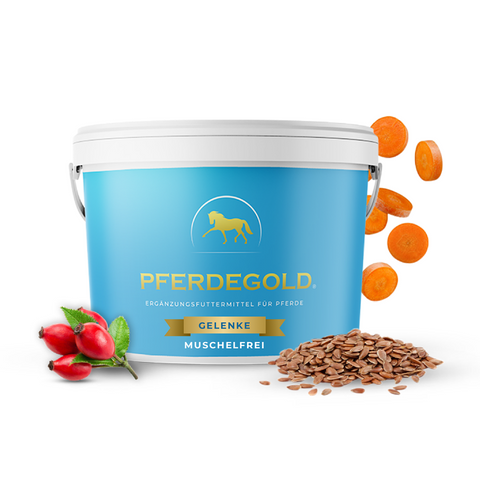
Florian ist aufgewachsen auf einem Bauernhof. Umgeben von Pferden, entdeckte er früh seine Faszination für diese majestätischen Tiere. Inspiriert von seiner reitbegeisterten Mutter, entwickelte er das Nahrungsergänzungmittel - Pferdegold. Seine tiefe Verbundenheit zur Natur und die leidenschaftliche Hingabe zu Pferden trieben ihn an, sein Unternehmen zu gründen.
Suspensory ligament damage in horses: Recognizing, treating & preventing
Suspensory ligament damage in horses is one of the most feared injuries in equestrian sports. This diagnosis often means months of training breaks and severely tests horse owners' patience.
The suspensory ligament is one of the most important structures in the horse's musculoskeletal system and contributes significantly to the stability of the fetlock joint. When this central "suspension" is damaged, the consequences are often more severe than with other tendon injuries.
In this comprehensive guide , you will learn everything you need to know about suspensory ligament damage in horses: from the first warning signs and causes to modern treatment methods and effective prevention strategies .
Veterinary examination of the suspensory ligament - early detection prevents serious damage
What is suspensory ligament damage in horses?
The suspensory ligament (ligamentum suspensorium) is a powerful ligament that originates from the posterior part of the cannon bone and divides into two branches above the fetlock joint.
The function of the suspensory ligament:
The suspensory ligament stabilizes the fetlock joint under load , supports the flexor tendons , and absorbs impact forces during walking . These functions make it one of the most important structures in the horse's leg.
Types of suspensory ligament damage
Depending on the location , a distinction is made between damage in the area of origin (difficult to diagnose), in the middle of the body (usually easily palpable) and in the branches above the sesamoid bones .
Depending on the severity , the spectrum ranges from slight strains to partial ruptures to, in rare cases , complete severance .
Detecting suspensory ligament damage: correctly interpreting warning signals
The insidious nature of suspensory ligament damage: It often develops gradually and is only detected late. However, early diagnosis is crucial for successful recovery.
🚨 Immediate warning signs:
- Sudden lameness after work or the next day
- Swelling on the side of the cannon bone or above the fetlock joint
- Warmth and pain when touching the tendon
- Relief posture – the horse stands unevenly
👁️ Recognize gradual development:
- Slight stiffness after intensive work
- Irregularities in gait when changing direction
- Reduced willingness to perform for no apparent reason
💡 Professional tip: Suspensory ligament damage often manifests itself through a characteristic "board lameness" – the horse walks stiffly and avoids bending the affected leg.
Daily check of the suspensory ligament - detect swelling and heat early
How do suspensory ligament injuries occur? Understanding the causes
Tendon ligament injuries rarely result from a single trigger. Usually, they are a combination of overload, fatigue, and unfavorable circumstances.
⚡ The main causes:
Suspensory ligament injuries usually occur due to acute overload such as peak loads when jumping, missteps or sudden changes of direction at high speed.
More common, however, are chronic overloads : too intensive training load, insufficient regeneration breaks or one-sided strain continuously weaken the suspensory ligament.
Middle-aged horses (8-15 years), sport and race horses and horses after long breaks from training are particularly at risk .
What to do if you have a suspensory ligament injury? First aid and treatment
Immediate action is crucial! The first few hours after the injury determine the entire healing process.
🛑 Immediate measures:
If suspensory ligament damage is suspected , immediate action is required : Training must be stopped immediately – even if lameness is only slight. The affected area should then be cooled for 15-20 minutes , which can be repeated every 2-3 hours. A support bandage to relieve pressure and strict stall rest until a veterinary examination are other important initial measures.
🚨 Call your veterinarian immediately if you notice any visible lameness, swelling of the suspensory ligament, warmth, or pain. There are no "harmless" cases of suspensory ligament damage.
💉 Modern therapy options:
Veterinary treatment begins with an ultrasound examination for a precise diagnosis . Depending on the healing progress, controlled exercise therapy follows. For severe injuries, modern procedures such as stem cell therapy or physical therapy with laser and magnetic fields are used.
Support bandage for suspensory ligament damage - Professional first aid for relief
Prevention: How to protect your horse's suspensory ligament
Prevention is the best protection! With well-thought-out measures, many tendon injuries can be prevented.
📈 Design your training intelligently:
Systematic training structure:
- Slow conditioning over several weeks
- Gradual increase in load – never sudden
- 15-20 minutes warm-up before intensive work
Especially after breaks:
- Comeback programs over 6-8 weeks
- First build endurance, then intensity
- Weekly increase of maximum 10%
🔍 Regular checks:
- Daily suspensory ligament checks after training
- Documentation of abnormalities
- Regular veterinary check-ups
Preventive nutrition for strong tendons
A targeted diet can contribute to preventative ligament health. By providing important nutrients, the ligament structures are strengthened from within.
🔧 Important nutrients for strong tendons:
- Collagen: basic building block for ligaments and tendon structures
- Glucosamine: building block for cartilage and connective tissue
- Chondroitin: Supports the elasticity of ligament structures
- Omega-3 fatty acids: anti-inflammatory effect
Green-lipped mussels - Natural source of Omega-3 for strong tendons
The optimal nutrient combination in Pferdegold Joints
- Green-lipped mussel: Rich in omega-3 fatty acids with anti-inflammatory properties
- Glucosamine: Natural building block for healthy connective tissue structures
- Chondroitin: Supports elasticity and water retention in tissue
- MSM: Natural sulfur supplier for strong binding tissue structures
⚠️ Important note: Pferdegold Gelenke is not related to the disease described in this article. It does not treat any disease and is not a substitute for veterinary diagnosis or treatment. This supplement can only be used as preventative support for healthy horses.

Pferdegold® Joints
This specially developed supplement is the natural joint nutrition for horses of all ages and promotes a healthy lifestyle. Made in Germany, grain-free, and backed by a 30-day money-back guarantee.
Order nowRehabilitation: The long road back
Patience is key! Suspensory ligament injuries often have long healing times and require a well-thought-out rehabilitation plan.
📅 Typical healing time:
Healing time varies greatly depending on the severity of the injury. Minor strains require approximately 3-6 months , while partial tears require 6-12 months to fully heal. Severe injuries can take 12-18 months or even longer —patience is key here.
🎯 Phased return:
- Strict crate rest with controlled hand movement (weeks 1-4)
- Footwork in hand (weeks 5-8)
- Light lunging at a walk (weeks 9-16)
- Easy riding at walk and trot (weeks 17-24)
- Gradual return to normal work (from week 25)
Rehabilitation after suspensory ligament injury - Patient development strengthens the bond
Frequently asked questions about suspensory ligament injuries
How long does the healing take?
The healing time varies depending on the severity: 3-6 months for minor injuries, up to 18 months for severe injuries.
Why do tendon injuries heal so slowly?
Suspensory ligaments have poor circulation and are constantly under tension, which slows down healing.
Can suspensory ligament damage occur again?
Yes, the risk is increased, especially if the initial healing was incomplete or rehabilitation was too rapid.
Conclusion: Take suspensory ligament damage seriously and prevent it properly
Suspensory ligament injuries are among the most serious injuries of a horse's musculoskeletal system. They require immediate action, consistent treatment, and, above all, tremendous patience.
The most important findings:
- Early detection through regular checks is crucial
- Preventive training with systematic structure protects best
- Immediate measures influence the healing process
- Rehabilitation takes time and should not be rushed
The key lies in prevention: With well-thought-out training, regular check-ups, and targeted support through optimal nutrition, you can significantly reduce the risk.
Perfect for your horse: Pferdegold® supplementary feed!
These specially developed supplements support your horse's diet and provide it with natural nutrients. Made in Germany, grain-free and drug-free, they come with a 30-day money-back guarantee.
IMPORTANT:
Pferdegold is not a substitute for veterinary diagnosis or treatment. The information contained in this article is for general informational purposes only and is intended to help improve your horse's well-being.
Pferdegold Joints is not related to the disease described in this article. It does not treat any disease and is not a substitute for veterinary diagnosis or treatment. This supplement can only be used as preventative support in healthy horses.

















